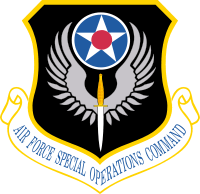17th Special Operations Squadron
| 17th Special Operations Squadron | |
|---|---|
|
17th Special Operations Squadron Patch | |
| Active |
2 March 1942 – 27 April 1946 20 October 1952 – 25 September 1953 1 June 1969 – 30 September 1971 1 April 1989 – present |
| Country | United States |
| Branch | United States Air Force |
| Type | Special Operations |
| Part of |
Air Force Special Operations Command 353d Special Operations Group |
| Garrison/HQ | Kadena Air Base |
| Motto(s) | No Mission Too Demanding |
| Mascot(s) | Jackal |
| Decorations |
|
The 17th Special Operations Squadron (17 SOS) is part of the 353d Special Operations Group at Kadena Air Base, Japan. It operates MC-130J Commando II aircraft providing special operations capability. Air crews are specially trained in day and night, low-level delivery of troops and equipment via airdrop or airland operations and flying using night vision goggles.
Mission
Deliver troops and equipment into denied areas during adverse weather conditions at night by airdrop or landing.[1]
History
The 17th flew antisubmarine patrols off west coast of US from, c. May–c. September 1942 then went on to fly combat missions in Southwest and Western Pacific from, 28 January 1944 – 25 July 1945.[2]
The squadron was activated but unmanned from, 1952–1953. It flew combat missions in Southeast Asia from, 1 June 1969 – 30 September 1971.
Throughout its history, the unit has been extremely active in humanitarian assistance and disaster relief. The 17th aided in Baguio Earthquake relief missions in the Republic of the Philippines from 16 –31 July 1990. In 2005, the unit supported Operation UNIFIED ASSISTANCE, the relief effort from the 2004 Indian Ocean Tsunami. In 2011, the unit supported Operation TOMODACHI, the relief effort from the Great East Japan Earthquake and Tsunami of 2011. In 2013, the unit supported Operation DAMAYAN, the relief effort from Super Typhoon Haiyan in the Republic of the Philippines.[2]
Operations
Lineage[2]
17th Reconnaissance Squadron
- Constituted as 17th Observation Squadron (Light) on 5 February 1942
- Activated on 2 March 1942
- Redesignated 17th Observation Squadron on 4 July 1942
- Redesignated 17th Reconnaissance Squadron (Bombardment) on 2 April 1943
- Inactivated on 27 April 1946
- Consolidated with 17th Liaison Squadron and 17th Special Operations Squadron as 17th Special Operations Squadron on 19 September 1985
17th Liaison Squadron
- Constituted as 17th Liaison Squadron on 19 September 1952
- Activated on 20 October 1952
- Inactivated on 25 September 1953
- Consolidated with 17th Reconnaissance Squadron and 17th Special Operations Squadron as 17th Special Operations Squadron on 19 September 1985
17th Special Operations Squadron
- Constituted as 17th Special Operations Squadron on 11 April 1969
- Activated on 1 June 1969
- Inactivated on 30 September 1971
- Consolidated with 17th Reconnaissance Squadron and 17th Liaison Squadron on 19 September 1985 (remained inactive)
- Activated on 1 August 1989
Assignments
- 71st Observation Group (later 71st Reconnaissance Group, 71st Tactical Reconnaissance Group): 2 March 1942 (attached to 91st Reconnaissance Wing c. 21 October – 9 November 1945, V Bomber Command 10 November 1945 – 31 January 1946)
- V Bomber Command: 1 February 1946 – 27 April 1946
- Western Air Defense Force: 20 October 1952 – 25 September 1953
- 14th Special Operations Wing: 1 June 1969 – 30 September 1971
- 353d Special Operations Group: 1 August 1989 – present
Bases stationed
- Providence, Rhode Island, 2 March 1942
- Salinas Army Air Base, California, 2 March 1942
- Esler Field, Louisiana, 24 January 1943
- Laurel Army Air Field, Mississippi, 31 March 1943 – 24 September 1943
- Milne Bay, New Guinea, 6 November 1943
- Dobodura, New Guinea, 22 November 1943
- Finschhafen, New Guinea, March 1944 – 30 June 1944 (air echelon at Wakde, New Guinea 25 May 1944 – 10 June 1944 and at Biak, New Guinea after 27 June 1944)
- Biak, New Guineam 29 July 1944
- Tacloban, Philippines, 2 November 1944 (air echelon primarily at Biak, New Guinea until ca. 23 December 1944, then at San Jose, Philippines
- San Jose, Philippines, 7 January 1945
- Lingayen, Philippines, 4 April 1945
- Ie Shima, Japan, 29 July 1945 (detachment remained at Lingayen until September 1945))
- Yokota Air Base, Japan, 26 October 1945 – 27 April 1946)
- McChord Air Force Base, Washington, 20 October 1952 – 24 September 1953
- Nha Trang Air Base, South Vietnam, 1 June 1969
- Phan Rang Air Base, South Vietnam. 15 August 1969 – 30 September 1971
- Kadena Air Base, Japan, 1 August 1989 – present)
Aircraft[2]
- L-1 Vigilant (1942)
- O-46 (1942)
- O-47 (1942)
- O-52 Owl (1942)
- A-20 Havoc (1942–1943)
- P-39 Airacobra (1942–1943)
- P-40 Warhawk (1942–1943)
- B-25 Mitchell (1943–1946)
- AC-119 (1969–1971)
- MC-130P Combat Shadow (1989 – 2014)
- MC-130J Commando II (2014–present)

